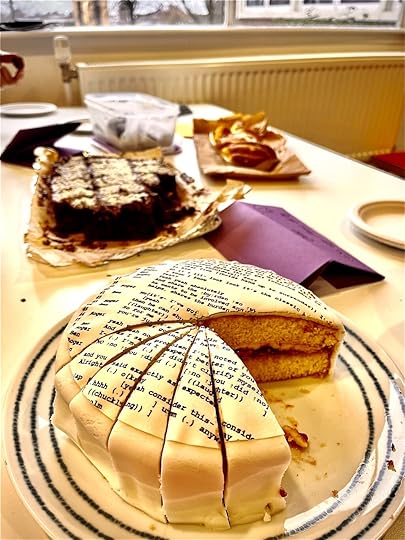The cake with a transcript! How do conversation analysts create cakes, erm transcripts?

Many of my friends and colleagues on Facebook and Twitter where I shared the picture of a cake with a Jeffersonian transcription admired the cake which was created by a colleague, Cat Holt, for the competition of Loughborough Conversation Analysis Day, 2022. Many thanks for your interest both in the cake and the transcript that was on the cake. I, as a conversation analyst, as you might have gathered, was thrilled to see the transcript on the cake 🙂 — and, obviously, to taste the cake.
Among the researchers who use conversation analysis to study (human) interactions, detailed transcripts (which we use in conversation analysis) are hard work — a lot of hard work! A transcript is not just a minute-by-minute verbatim detail of an interaction in our case i.e., conversation analysis — transcripts are our blood, sweat and tears literally!
Decades of empirical research and findings from Conversation analysis since the late 1960s and early 1970s when it was developed, have demonstrated how systematic interaction is, and the remarkable orderliness of our conversations. Each specific type of conversation has particular kind of patterns, i.e. there is a beginning and there is an end, and things happen in between, for example, a normative place of a greeting is always at the beginning of an interaction which is paired with a reply in return — which can be missing in some interactions. The distance — pauses which are measured by the conversation analyst — between the two turns-in talk (greetings in this case) inform the analysts what is going on between the interlocutors. Simply put, Conversation analysis provides a model to study talks — a scientific method to study talks.
We start our research project with video recordings, which are forensically transcribed, and then they are analyzed. The data used in CA is preferably in the form of video-recorded conversations, which are gathered with the help of one or more cameras after seeking permission from the participants. Video recordings provide the analyst with authentic information and all researchers (who are not present during the recordings) can observe the data directly without the help of a narrative created by another researcher or the participant under study. In other words, instead of someone (a participant) informing us what they think they were doing, we look at what the participants were actually doing.
Conversation analysts study conversations of all sorts, for example, anything from a dental appointment to court trials, and from family dinners to first dates. Everything we do as humans are done through talks, from complaints to arguments, to questioning, and so on and so forth.
A conversation analyst is trained by working on tons of video-recorded data in data sessions where a close group of researchers bring their video-recorded data and transcripts. In my case, for example, during my PhD studentship days between 2009–2014, I went to our fortnightly data sessions every single month with a few exceptions. The data sessions are where conversation analysts look at a video clip and transcripts prepared by the presenting researcher. Usually, the video clips are no more than one to two minutes long — and the data sessions are usually about two-hour-long work-in-progress seminars where video recorded data is repeatedly watched and analysis is done collaboratively by each researcher commenting on the various aspects, which, in turn, is drawn from the theoretical and methodological readings of the subject.
The transcripts are created by spending hours and hours listening to intonation, speech markers, breath, laughter etc. Everything is marked in the transcript, nothing is left behind including gestures and bodily movements.

Transcripts are like a cake with the icing — for the conversation analysts, more details are always better; video-recorded data are like raw ingredients for the cake! I hope you got some this insight into how conversation analysis is done, and it is not a piece of cake to create such transcripts!
[image error]Languaging, literature, culture and landscape
- Alia Amir's profile
- 41 followers



